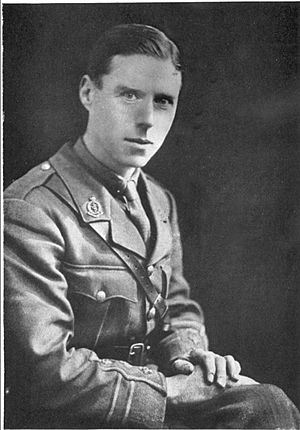Frederick Twort facts for kids
Quick facts for kids
Frederick Twort
|
|
|---|---|

Frederick Twort
|
|
| Born | 22 October 1877 |
| Died | 20 March 1950 (aged 72) |
| Nationality | English |
| Alma mater | St Thomas's Hospital |
| Known for | Bacteriophages |
| Parent(s) |
|
| Awards | Fellow of the Royal Society |
| Scientific career | |
| Fields | Bacteriology |
| Institutions | University of London |
Frederick William Twort (born October 22, 1877 – died March 20, 1950) was an English scientist who studied bacteria. He is famous for discovering bacteriophages in 1915. These are special viruses that infect and destroy bacteria.
Twort studied medicine in London. He became a professor of bacteriology at the University of London. He also led a research center for animal diseases. His work helped us understand diseases like Johne's disease in cattle. He also found that vitamin K is important for growing leprosy bacteria.
Contents
Early Life and Training
Frederick Twort was born in Camberley, Surrey, on October 22, 1877. He was the oldest of eleven children. His father, Dr. William Henry Twort, was also a doctor.
Frederick started studying medicine in 1894 at St Thomas's Hospital in London. After he became a qualified doctor in 1900, he worked as an assistant. He learned many skills for studying diseases. In 1902, he became an assistant to a bacteriologist at the London Hospital. He handled all the daily tests for the hospital.
In 1909, Twort became the leader of the Brown Animal Sanatory Institution. This was a research center focused on animal diseases. He stayed there for his entire career. In 1919, Twort married Dorothy Nony. They had three daughters and one son.
Important Discoveries
Frederick Twort made several important discoveries in his career. Many of his ideas were ahead of his time.
How Bacteria Change
Early scientists often sorted bacteria by how they grew on different foods. Twort found that this method had problems. He saw that bacteria could change over time. They could gain new abilities, like being able to use new types of sugar for food.
Twort showed that bacteria are not always fixed. They can change and adapt to new conditions. This idea was very new then. It helped future scientists understand how bacteria can evolve.
Growing Leprosy Bacteria
In the early 1900s, leprosy was a big problem. Scientists found it very hard to grow the leprosy bacteria in the lab. This made it difficult to study the disease.
Twort thought that leprosy bacteria might need something special to grow. He believed it was similar to the bacteria that causes tuberculosis. He added dead tuberculosis bacteria to the growth food for leprosy. This worked! He was able to grow leprosy bacteria for the first time.
He found that the special substance needed was vitamin K. This experiment showed that some organisms need specific things from others to grow. This idea is now a basic part of studying how bacteria get their food.
Understanding Johne's Disease
Twort also studied Johne's disease. This is a long-lasting gut infection in cattle. Like leprosy bacteria, the Johne's bacteria was hard to grow.
Twort used the same method he used for leprosy. He added dead tuberculosis bacteria to the growth food. This allowed him to grow Johne's bacteria successfully. This discovery was quickly recognized by other scientists.
Discovering Bacteriophages
One of Twort's most famous discoveries was made in 1915. He and his brother were trying to grow viruses in the lab. They hoped to find a harmless virus that could help them understand harmful ones.
At the time, smallpox vaccines were made using calves. These vaccines often had bacteria called Staphylococcus mixed in. Twort thought these bacteria might have something special that the vaccinia virus needed to grow.
He put some smallpox vaccine on a special dish where bacteria could grow. He saw large colonies of bacteria. But when he looked closely, he saw tiny clear spots within the colonies. These spots were areas where the bacteria were being destroyed. He found that he could take some of this "destroying agent" and transfer it to other bacteria colonies.
Twort did more tests. He found that this agent could pass through very small filters. He also saw that it needed bacteria to grow. These observations showed that Twort had discovered most of the key features of bacteriophages. He thought it might be an enzyme from the bacteria.
Twort published his findings in a science journal called The Lancet in 1915. He called it the "bacteriolytic agent." Sadly, his discovery was not widely noticed at the time. A French-Canadian scientist, Félix d'Herelle, discovered phages independently a few years later. Twort's work might have been forgotten if other scientists had not found his paper later.
Later Career
After World War I, Twort continued his research. He hoped that bacteriophages could be used to treat bacterial diseases in humans and animals. However, this did not work out as planned.
Twort then went back to his idea that these agents needed a special "essential factor" to grow. He tried to find a way to grow viruses without a living host. He even tried to show that bacteria might have evolved from viruses. These experiments did not succeed, but they were very forward-thinking.
In 1929, Twort was recognized for his important work and became a Fellow of the Royal Society. This is a very high honor for scientists in the UK. In 1931, the University of London made him a Professor of Bacteriology. They praised his research and his teaching skills.
However, financial support for his research became harder to get. His lab was destroyed by a bomb in 1944 during World War II. After this, the University of London ended his position. Twort died on March 20, 1950. His discovery of bacteriophages is now seen as a very important moment in science.

